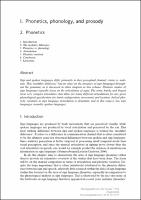Chapter 2 Phonetics
| dc.contributor.author | Crasborn, Onno | |
| dc.contributor.editor | Pfau, Roland | |
| dc.contributor.editor | Steinbach, Markus | |
| dc.contributor.editor | Woll, Bencie | |
| dc.date.accessioned | 2019-11-18 23:55 | |
| dc.date.accessioned | 2020-01-07 16:47:06 | |
| dc.date.accessioned | 2020-04-01T09:28:22Z | |
| dc.date.available | 2020-04-01T09:28:22Z | |
| dc.date.issued | 2012 | |
| dc.identifier | 1006380 | |
| dc.identifier | OCN: 1135853891 | en_US |
| dc.identifier.uri | http://library.oapen.org/handle/20.500.12657/23762 | |
| dc.description.abstract | Sign and spoken languages differ primarily in their perceptual channel, vision vs. audition. This ‘modality difference’ has an effect on the structure of sign languages through-out the grammar, as is discussed in other chapters in this volume. Phonetic studies of sign languages typically focus on the articulation of signs. The arms, hands, and fingers form very complex articulators that allow for many different articulations for any given phonological specification for hand configuration, movement, and location. Indeed phonetic variation in sign language articulation is abundant, and in this respect, too, sign languages resemble spoken languages. | |
| dc.language | English | |
| dc.subject.classification | thema EDItEUR::C Language and Linguistics::CF Linguistics | en_US |
| dc.subject.other | Sign Language | |
| dc.subject.other | Language Typology | |
| dc.subject.other | Grammar | |
| dc.subject.other | Psycholinguistics | |
| dc.subject.other | Neurolinguistics | |
| dc.subject.other | Sociolinguistics | |
| dc.title | Chapter 2 Phonetics | |
| dc.type | chapter | |
| oapen.identifier.doi | 10.1515/9783110261325.4 | |
| oapen.relation.isPublishedBy | 2b386f62-fc18-4108-bcf1-ade3ed4cf2f3 | |
| oapen.relation.isPartOfBook | 46384546-3661-450a-87ee-8613fea7d1b7 | |
| oapen.relation.isFundedBy | 7292b17b-f01a-4016-94d3-d7fb5ef9fb79 | |
| oapen.relation.isbn | 9783110204216 | |
| oapen.collection | European Research Council (ERC) | |
| oapen.place.publication | Berlin/Boston | |
| oapen.grant.number | 210373 | |
| oapen.grant.acronym | ON THE OTHER HAND | |
| oapen.identifier.ocn | 1135853891 |

